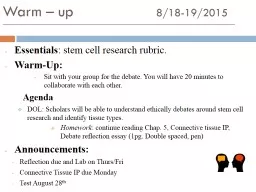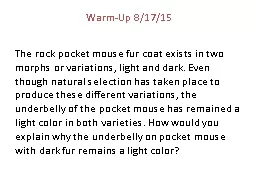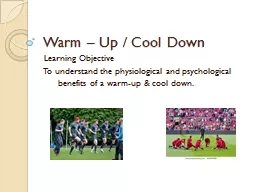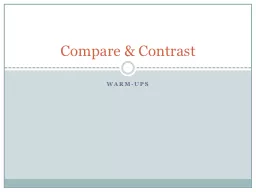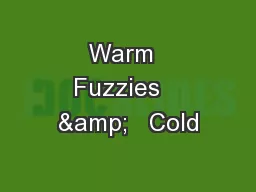PPT-Warm – up 8/18-19/2015
Author : crandone | Published Date : 2020-06-25
Essentials stem cell research rubric WarmUp Sit with your group for the debate You will have 20 minutes to collaborate with each other Agenda DOL Scholars will
Presentation Embed Code
Download Presentation
Download Presentation The PPT/PDF document "Warm – up 8/18-19/2015" is the property of its rightful owner. Permission is granted to download and print the materials on this website for personal, non-commercial use only, and to display it on your personal computer provided you do not modify the materials and that you retain all copyright notices contained in the materials. By downloading content from our website, you accept the terms of this agreement.
Warm – up 8/18-19/2015: Transcript
Essentials stem cell research rubric WarmUp Sit with your group for the debate You will have 20 minutes to collaborate with each other Agenda DOL Scholars will be able to understand ethically debates around stem cell research and identify tissue types . th. Six Weeks. February 17, 18 . Warm Up 1. *Note this is the first warm-up of the next 6 weeks!. Put your MLA heading at the top of the warm-up. Title: Synthesis Source . Take out the source you brought to class and answer the following questions. You will have 10 minutes to write. . WtK. ). Warm up 9-1-2015. Correct the following sentence.. Are boss told me and Channing your flirting to much. Warm Up 9-2-2015. Identify the type of irony exemplified.. In real life, an ambulance comes to a woman's house to take her to the hospital, hopefully to save her life. On the way to the hospital the ambulance is hit by a semi-truck and everyone on board the ambulance is killed. . 1.) Many examples that he talks about (is/are) on culture.. 2.) The tornadoes that tear through this county every spring (is/are) more than just a nuisance. . 3.) Every student in all the high schools (is/are). Tuesday October 1. Warm up: p 129 map 1&2. Class: present political cartoons/skits. Play taboo. Create vocab taboo. Unit 9. Warm-up 1: Polar Seas - Intro. How are . polynyas. defined?. In general, . . water holds more oxygen than . . water.. Why are there higher productivity levels in the polar sea summers than in the polar sea winters?. The rock pocket mouse fur coat exists in two morphs or variations, light and dark. Even though natural selection has taken place to produce these different variations, the underbelly of the pocket mouse has remained a light color in both varieties. How would you explain why the underbelly on pocket mouse with dark fur remains a light color?. Unit 2. Warm-up 1: Earth’s water. Approximately, what percent of the earth’s surface is covered with ocean water?. Where do all the ocean basins connect?. Name the four major ocean basins.. Give an example of a body of water that might connect the basins together.. PAD3O. How to Stay Warm and . Happy. Dress appropriately for the current weather conditions and be prepared for weather changes to extremes in either direction (warmer, colder, wetter, and drier). . This is best accomplished by using the following layering system. Learning Objective. To understand the physiological and psychological benefits of a warm-up & cool down.. Effective warm-up should include:. General warm-up. (pulse raiser). Stretching. Specific warm up . The prisoner was . emaciated. after a month of nothing but bread and water.. The . manacles. on his wrists and ankles prevented the prisoner from escaping.. The . queue. to buy tickets for Jose’s stand-up comedy show stretched all the way around the building. Chad Workman. “Did you ever see a lion warm up before it takes down a gazelle?”. Rebuttle. : That’s why lions aren’t smart enough to be at the top of the food chain.. Purpose. Thermogenesis. Joint Mobility. Warm-up #1 10/13/14. How are apples and oranges the same? How are they different?. What are some reasons why you would compare apples and oranges?. You are trying to persuade a friend to eat an apple instead of an orange – what arguments could you use?. Pricklies. We are . ALL. special. Doctor Appointments. School Activities. Friends/Family. Birthmarks. Why . (insert child’s name) . is special. Bodies all work differently. Doctor Appointments. Extra Medications. John I. Duval, P.E., LEED AP. Alaska Asphalt Paving Summit. October 31, 2011. Overview. WMA Snapshot circa 2011. What is Warm Mix Asphalt?. Why Warm Mix Asphalt is the Future of our Industry. WMA Success Stories.
Download Document
Here is the link to download the presentation.
"Warm – up 8/18-19/2015"The content belongs to its owner. You may download and print it for personal use, without modification, and keep all copyright notices. By downloading, you agree to these terms.
Related Documents

